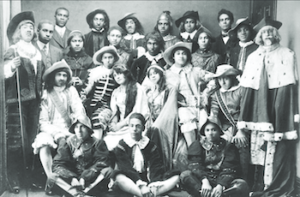
Howard Players, 1922
*Thelma Duncan Brown was born on this date in 1902. She was a Black writer, teacher, and stage producer.
A St. Louis, Missouri-born writer, she received her college education at Howard University, Washington, DC, and Columbia University, New York. At Howard, during the 1920s, she discovered her writing talents under the tutelage of Thomas Montgomery Gregory of the University’s Department of Dramatics and Public Speaking. Her play, “The Death Dance,” in 1921 and later published in Plays of Negro Life (1927), edited by Gregory and Alain Locke, was among the earliest productions of the Howard Players, the school’s drama troupe.
Other works produced by the Howard players included those by Howard-trained playwrights Helen Webb's “Genefrede” (1922)1 and DeReath Irene (Beausey) Byrd's “The Yellow Tree” (1922)2. In 1923, the Howard Players presented “The Death Dance” in Rankin Memorial Chapel on the Howard campus and Baltimore’s Douglass Theatre to help fund a theatre laboratory at Howard University. Duncan graduated from Howard (cum laude) with a degree in music. She reluctantly embarked on a career as a music teacher, working in North Carolina while continuing to write, before setting out on a motor trip through New Mexico, El Paso, Texas, and Mexico. By 1929, the writer had returned to La Junta, Colorado, and her parents' home, hoping to pursue a full-time writing career.
In 1930, a version of Duncan’s one-act play “Sacrifice” was published in playwright Willis Richardson’s Plays and Pageants from the Life of the Negro. However, the then twice-published playwright had earned little money from her craft and regretfully continued teaching music to earn a living. Duncan expressed her dismay in a 1931 letter to Gregory, who continued to mentor her well after her Howard days: “I was never fond of my work as a teacher, and I don’t want to teach again if I can do anything else. My whole thoughts seem to be writing something whether it turns out worthwhile or not.”
Earlier that same year, her play, “African American Magic,” a revised version for which she had won a prize while in North Carolina, was published in the Yearbook of Short Plays, edited by Claude Merton Wise. Duncan wrote at least two other plays, “The Witch Woman” and “Hard Times,” hoping they would be included in another collection that Wise planned but never completed “on account of depression,” according to the playwright. In 1932, at thirty, she married Mr. Brown, whom she described as “an adorable husband” and “interested” in her work as a writer.
As she referred to herself from that point, Thelma Duncan Brown lived with her husband in Albuquerque, New Mexico, where she worked on a novel, Ham’s Children. That year, the playwright had some success as a short story writer, with two of her works being published in Bronsman. Thelma Myrtle Duncan Brown, who was among an elite group of black University student playwrights in America who established themselves as “cornerstones” of an emerging National Negro Theatre during the early decades of the 20th century, died on July 29, 1987.